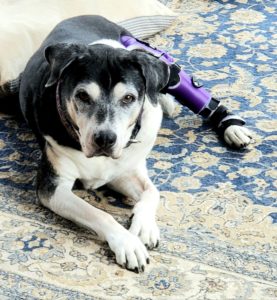There is sorrow enough in the natural way
From men and women to fill our day;
And when we are certain of sorrow in store,
Why do we always arrange for more?
Brothers and sisters, I bid you beware
Of giving your heart to a dog to tear.
– Rudyard Kipling, The Power of a Dog
Michael Baugh KPA-CTP CPDT-KSA CDBC
I heard crying in the other room. There was Tim, my husband, clutching our dog Stewie. “What’s wrong,” I asked. “I don’t want him to die,” he answered. I could barely make out the words through the sobbing. “He’s growing old.” Stewie, very much alive, 13 and white-faced (but healthy), had no idea what was going on. But, I did. I knew because I’d been here before.
My late dog, Juno, was 11 1/2 when she died. The cancer started 18 months earlier. And really, that’s when the grieving started too. Mast cell. The words didn’t mean much to me at the time, but the look on my vet’s face said all I needed to know – all that I already knew. We all know. We die. Those we love die. Our dogs eventually die. The thing is we work so hard every day to forget. We distract ourselves. We keep busy. We fill the time or let it pass. It’s woven into being human, this knowing and not wanting to know. There are books about it. It’s the stuff of our best stories. Philosophy. Religion. This angst. Living and dying.
We forget until we can’t. Death just shows up, sometimes when we don’t expect it. Early. Shockingly. But it’s never really a surprise, not if we’re being honest with ourselves. Or it comes with a prelude, a diagnosis, a slowing body, more birthdays past than ahead. It’s a white-faced dog with dewy eyes looking up at our tear-wet face, with 13-years dragging behind us both. And, we know 15 is a dream – 17 is nearly impossible.
Anticipatory Grie f. It sounds clean and clinical. Experiencing it, though, is something different. Mourning a living dog (or any pet, or person for that matter) can feel a bit – well – morbid. It can be messy and confusing. For me it felt isolating. The truth is I thought I was the rare one who would suffer such an odd thing upon myself. But, I was not.
f. It sounds clean and clinical. Experiencing it, though, is something different. Mourning a living dog (or any pet, or person for that matter) can feel a bit – well – morbid. It can be messy and confusing. For me it felt isolating. The truth is I thought I was the rare one who would suffer such an odd thing upon myself. But, I was not.
Anticipatory Grief is normal. “Google it.” That’s what my friend Dr. Risë VanFleet said when I asked her about it. She’s a Psychologist and a Certified Dog Behavior Consultant. I did Google it. The screen filled with heartbreaking normal. This is what we do. We mourn illnesses (our own and others’). We mourn the loss we know is coming. Dr. VanFleet says it’s normal to feel these feelings and even shed some tears. “It’s okay to say ‘this is going to be really rough.'” Normal doesn’t mean easy, though. Grief hurts. And, the hurting sometimes starts long before the loss.
Anticipatory Grief can feel different. Nearly all the articles on that Google search mentioned what I had experienced myself. Sometimes Anticipatory Grief is more intense than so-called simple grief after the death. When I lost Juno I was devastated. I sobbed. But, the feelings I had before were different. The crying came on faster and unexpectedly. I’d double over and hold on to her as if my tears and my grip could save her from the cancer. As if they could somehow slow time. I felt guilt because I imagined her death over and over. I felt shame because Juno was still alive (how could I do this to her?). Dr. VanFleet warns of a dark side to Anticipatory Grief. Feel the feelings but stay aware. There is the danger of letting our thoughts spiral into depression.
Anticipatory Grief can also be a good thing. I’m not a silver lining kind of guy. Dr. VanFleet doesn’t seem to be the Pollyanna type either. But, I had to wonder. If Anticipatory grief is so common (normal, in fact) does it serve a purpose? It turns out the answer is yes. Certainly it can prepare us for the loss. Don’t mistake that for getting it all out of your system (sorry, grief don’t work that way). Anticipatory Grief can, however, help us get ready for what life will be like without our dog. This is especially true if we are talking about a service dog or even an emotional support dog. In my case Juno was a dog I’d built a business with. She was my co-worker as much as a friend. Stewie is too.
“Think about what that animal has meant to you.” That’s Dr. Van Fleet’s advice. But, do it now while he’s still alive. “Don’t save it for later.” Maybe the greatest gift of Anticipatory Grief is this. Even while it’s casting us into the future of our dogs death, it’s also pulling us right back into the present moment. Because our dog is still with us. And, we are right here with him. Right now. “This is not a eulogy or an obituary. She is still alive. Under the desk, just inches away….” That’s the first line of a blog piece I wrote months before Juno died. I called it For Juno, but really it’s the best gift I ever gave myself. I was grieving a future that was yet to come. And I was so present with her, because every moment mattered that much more. That’s the gift of this oddly intense early grief.

 Risë VanFleet specializes in Animal Assisted Play Therapy®. Her dog Kirrie has been her partner in that work for the better part of 16 years. Kirrie is dying. It’s cancer. Months remain. Maybe weeks. They don’t know. In younger years Kirrie would sometimes disturb VanFleet while she was working, a simple ask for attention, a ball in her mouth and a plaintive look. “I’d say just a minute.” VanFleet tells the story like she’s told it before, like she loves telling it because Kirrie is her favorite subject. “I’d say it two or three times, putting her off, until I finally thought ‘is this the relationship I want to have?'” It was years ago but it feels like she’s asking again. Asking herself. Asking Kirrie. “Now I only say ‘just a minute once.’ Then I stop what I’m doing and spend a little time with her.”
Risë VanFleet specializes in Animal Assisted Play Therapy®. Her dog Kirrie has been her partner in that work for the better part of 16 years. Kirrie is dying. It’s cancer. Months remain. Maybe weeks. They don’t know. In younger years Kirrie would sometimes disturb VanFleet while she was working, a simple ask for attention, a ball in her mouth and a plaintive look. “I’d say just a minute.” VanFleet tells the story like she’s told it before, like she loves telling it because Kirrie is her favorite subject. “I’d say it two or three times, putting her off, until I finally thought ‘is this the relationship I want to have?'” It was years ago but it feels like she’s asking again. Asking herself. Asking Kirrie. “Now I only say ‘just a minute once.’ Then I stop what I’m doing and spend a little time with her.”
Time. We measure it in years or months or weeks. But we tell it in moments. Moments with our dogs. This moment, the one we have now, the one we will hold on to when we can’t hold our dogs anymore. “We still have them.” Dr. VanFleet interrupts my wandering thoughts. We do still have them. For now. Right now.
“He’s growing old.” Tim says again, one more time, more quietly. Stewie rests his head and curls his front legs in that melt-your-heart way he has about him. Tim quiets and the tears stop. I watch for a moment, these two, pressed one to the other, breathing in the same rhythm.
Michael Baugh teaches dog training in Houston, TX. He and Tim live with two dogs, Stewie (13) and Stella (10). For more photos of Stella and Stewie visit www.facebook.com/michaelsdogs. To learn more about Dr. VanFleet’s work and see more photos of her dogs visit her professional facebook page.

